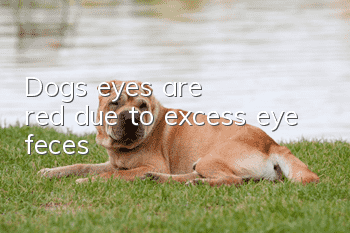Dog's eyes are red due to excess eye feces

If a dog has a lot of eye feces and is accompanied by red eyes, it can basically be judged as conjunctivitis. Owners can wear Elizabethan rings on their dogs and use some anti-inflammatory eye drops. However, some dogs’ conjunctivitis may be caused by viruses, and owners need to further check their dogs for canine distemper virus.
Symptoms of conjunctivitis
1. The dog’s eyes are watery and afraid of light.
2. The eyes are red, edematous, and painful.
3. A lot of sticky eye feces will be secreted.
4. In a few serious cases, the swelling is obvious, the pain worsens, and yellow-white pus will flow out of the eyes.
Conjunctivitis Treatment
1. When acute conjunctivitis is severely congested, wash your eyes with 3% boric acid solution or 0.1% Rivanol solution, apply cold compresses, and apply anti-inflammatory eyes ointment, 4 times a day. When the pain is severe, 2% cocaine can be used for eye drops. For chronic conjunctivitis, hot compresses can be applied, and concentrated zinc sulfate or silver nitrate solution can be applied locally to the eyes. If the nipple proliferates and forms follicles, crystallized copper sulfate can be used for cauterization.
2. For conjunctivitis complicated by canine distemper and canine infectious hepatitis, chloramphenicol ointment should be applied to the conjunctival sac 1 to 3 times a day on the basis of treating the primary disease. Caused by mycoplasma and chlamydia, choose chloramphenicol eye drops to instill in the eyes, 2 to 3 times a day. Drug selection for bacterial infections should be based on drug susceptibility testing. For fungal conjunctivitis, use amphotericin B125μm, subconjunctival injection every other day, for 2 weeks. This drug is toxic to conjunctival tissue and cannot be used for eye drops.
3. For conjunctivitis caused by physical and chemical factors, the cause should be removed first. If the corneal tissue is not damaged, 0.05% flumetasone eye ointment can be applied in the conjunctival sac, 1 to 3 times a day; when acid or alkali invade, the eyes must be washed thoroughly for 5 to 10 minutes.
4. For conjunctivitis with allergic factors, the allergen should be removed and thimerosal should be instilled in the eyes 5 to 6 times a day. Or put lead sulfate solution into the eyes, 3 to 5 times a day. Use broad-spectrum antibiotics as appropriate.
5. For stubborn purulent conjunctivitis, 1% iodoform ointment should be applied, and procaine penicillin should be used to seal the fundus.
- Why do dogs like to eat poop?
- What should you pay attention to when training a border collie?
- How to train a dog not to eat randomly
- What is the best food for newborn puppies to eat?
- How to choose pet cans for dogs and cats?
- What foods should never be given to dogs?
- Neapolitan Mastiff’s Habits, Characteristics and Breeding Methods_Introduction
- The reason behind dogs barking
- What should I do if my Dachshund suffers from skin diseases?
- What are the symptoms of gastric disease in dogs?



